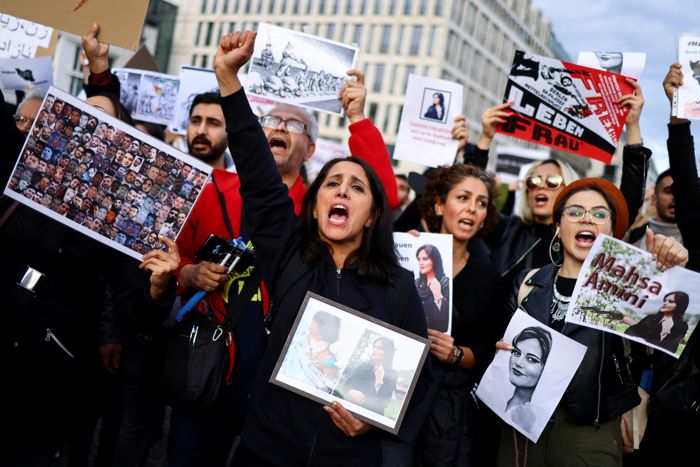“Woman, Life, Freedom” Iranian Women Inspire
People take part in a protest following the death of Mahsa Amini, in front of the Brandenburg Gate in Berlin, Germany, September 23, 2022. REUTERS/Christian Mang TPX IMAGES OF THE DAY
The death of a young Kurdish woman in mid-September has brought Iran’s stringent laws to the forefront of worldwide attention. Anti-government protests have spread to dozens of cities and towns in Iran. While largely reacting to the government’s enforcement of the hijab law, the protests have also reflected Iranians’ anger over years of an unsteady economy. Iran has a long history of women asserting their rights, even before the 1979 Islamic Revolution. It has appealed to people from all walks of life. The Iranian government has responded with a harsh crackdown, further fueling the discontent.
Mahsa Amini’s Death
On September 13, 2022, Mahsa Amini, 22, was arrested on an accusation of violating the hijab law, which legally obligates women in Iran to cover their heads in public.
Amini died three days later.
Iran’s security forces claimed she died from a heart attack while in custody. However, her family disputed that she was beaten to death by the morality police. Amini’s controversial death has led to outrage over the nation’s laws. Iranian women are ripping and burning head coverings as an emblematic gesture of their much-needed autonomy. Many Iranians are joining protests fueled by broader dissatisfaction with the incumbent theocratic government. Years of economic downfall because of US-led sanctions have ushered in food shortages, a lack of jobs, and mounting inflation.
Government Response
The Supreme Leader, Ayatollah Ali Khameini’s theocratic rule has been at the heart of anti-government protests, with demonstrators chanting, “Death to the dictator!” Protestors are calling for the downfall of the Islamic Republic. The government has responded by deploying large units of police officers firing on demonstrators with water cannons and guns and beating them with batons. As of October 21, an estimated 244 protestors have been killed and over 12,500 arrested, according to the Human Rights Activists News Agency (HRANA). Independent media organizations have been prohibited from reporting in Iran, making it hard to verify what state media reports on deaths and casualties.
President Ebrahim Raisi has accused the “Great Satan” United States of inciting “chaos, terror, and destruction” in Iran. His statements have been widely dismissed as unfounded.
Iranian Women and their Power of Resistance
The slogan, “Woman, life, freedom,” is reverberating on the streets of Tehran, Shiraz, and Mashhad. Young Iranian women are fighting for their blanket autonomy in all sectors of life. They are inspiring women worldwide who are also questioning draconian laws in their respective countries. They have begun to recognize that life can be lived differently. Women are silently protesting by removing their hijabs. Schoolgirls are taking the fight to classrooms, crying, “Clerics, get lost!”
Amidst everything, countless young girls have died fighting for their civil rights. Asra Panahi, a 16-year-old schoolgirl, was beaten to death for refusing to sing a pro-regime anthem. Sarian Esmailzadeh, a 16-year-old video blogger who questioned the status quo, was beaten to death in a protest. Hadis Najafi, 22, a TikToker, posted a video on her way to a protest and said, “I hope in a few years when I look back, I will be happy that everything has changed for the better.” She was shot to death an hour later.
Gen Z women are using digital platforms as a forum for dissent. They are taking to the streets and social media, documenting their struggles. Nobel Laureate, Shirin Ebadi, is hopeful that Iranian women will succeed in democratizing Iran. “Democracy in Iran will arrive through women.”
Samya Madhukar (she/her) is a junior at Shaker High School and is serving her first year as Co-Editor-In-Chief and Writing & Editing Team Leader for...


